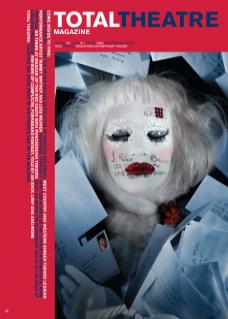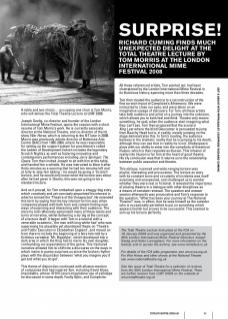A table and two chairs… occupying one chair is Tom Morris, who will deliver the Total Theatre Lecture at LIMF 2008.
Joseph Seelig, co-director and founder of the London International Mime Festival, opens the session with a short resume of Tom Morris’s work. He is currently associate director at the National Theatre, and co-director of the hit show War Horse, which is returning to the NT later in 2008. Morris was previously artistic director of Battersea Arts Centre (BAC) from 1995-2004, where he was responsible for setting up the support system for practitioners called the Ladder of Development (which includes the legendary Scratch Nights), as well as fostering innovative and contemporary performances including Jerry Springer: The Opera. Tom then invited Joseph to sit with him at the table, and handed him a whistle. He was instructed to blow it after thirty minutes as a warning that he had ten minutes left and at forty to stop him talking – he would be giving a ‘Scratch’ lecture, and he would only know what the lecture was about after he had given it. Clearly, this was not going to be a standard lecture.
And so it proved, for Tom embarked upon a shaggy dog story which creatively and yet concisely pinpointed his interest in what he termed the ‘Theatre of the Unexpected’. He extended this term by saying that the key interest for him was when companies played with both form and content finding new ways of surprising and interacting with their audience. The story he told reflexively epitomised many of these twists and turns of narrative, whilst delivering a sly dig at the concept of a lecture itself. It began with Tom in a tutorial with a venerable academic, ‘the man with long white hair’ who was supervising his plausible yet abandoned thesis on ‘Theatre and Public Execution in Elizabethan England’, and moved on from there to include the beginning of a fairy tale told by a fictitious caretaker ‘Mr. Bigadyke’, which developed into a dark area in which the King had to marry his own daughter, confounding our expectations of the genre. This fractured narrative allowed him to shift into a discourse on the ways in which metre in poetry surprises us since the broken rhythm plays with the disjunction between ‘what you imagine you’d get and what you do get’.
This theme of disjunction continued with allusive mention of companies that had inspired Tom, including David Glass, Improbable, whose 70 Hill Lane’s imaginative use of sellotape he discussed in some depth, Faulty Optic, and Complicite. All these referenced artists, Tom pointed out, had been championed by the London International Mime Festival in its illustrious history, spanning more than three decades.
Tom then treated the audience to a reconstruction of the first scratch tryout of Complicite’s Mnemonic. We were instructed to close our eyes, and were taken on an imaginative voyage of discovery. For Tom, all these artists take both audience and artist on a journey into the unknown, which allows you to both feel and think. Theatre only means something, he said, when the audience start imagining what they can’t see. Tom then proposed that the scene in King Lear where the blind Gloucester is persuaded to jump from Beachy Head but is, in reality, merely jumping on the stage demonstrates this. In Tom’s reading, the audience believes in the dramatic reality that he is jumping to his death, although they can see that in reality he is not. Shakespeare plays with our ability to enter into the complicity of theatrical illusion, which is then revealed as illusion. This infusion of reality into illusion is for Tom at the heart of good theatre. His sly conclusion was that it returns us to the relationship between public execution and theatre.
This oblique, nuanced and wide-ranging lecture was playful, interesting and provocative. The lecture as story with its constant turns and circularity of incidents was itself surprising and unexpected, and challenged us to wonder whether they were real or fictional. It revealed the importance of placing theatre in a dialogue with other disciplines as a means of constant renewal. The question and answer session afterwards was provocative and Tom’s response to the question, ‘What has been your journey at The National Theatre?’ was, in effect, that he sees himself as the outsider who is occasionally permitted to put on something which appears foolish but proves to be successful. This seemed to sum up his lecture perfectly.
The Total Theatre Lecture took place at the ICA on 19 January 2008 and was organised and presented by the 30th London International Mime Festival (directors Joseph Seelig and Helen Lannaghan). For more information on the festival, and to access the archive, see www.mimefest.co.uk
For details of the ICA talks programme, see www.ica.org.uk For War Horse and other shows at the National Theatre see www.nationaltheatre.org.uk
See this issue of Total Theatre for a selection of reviews from the 30th London International Mime Festival. There are further reviews from LIMF 2008 on the website at www.totaltheatre.org.uk

